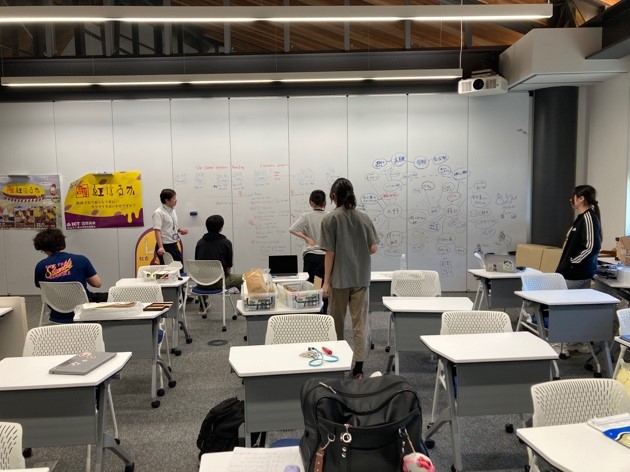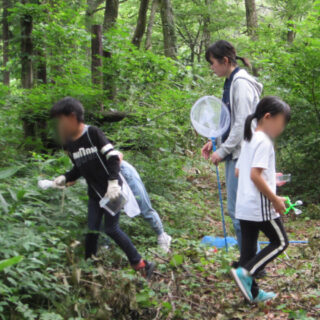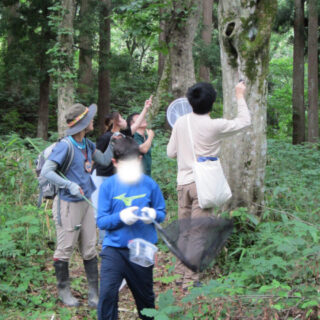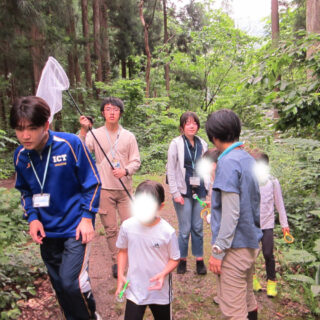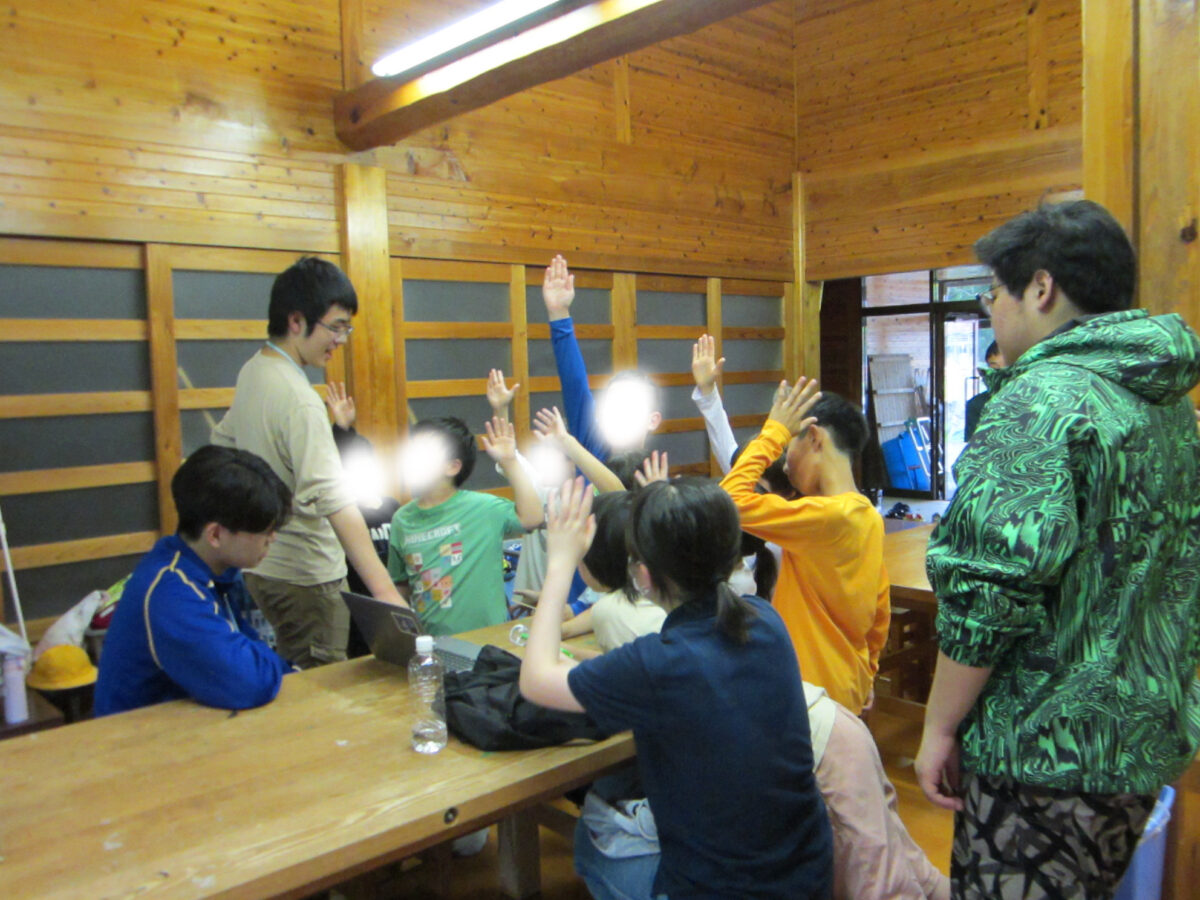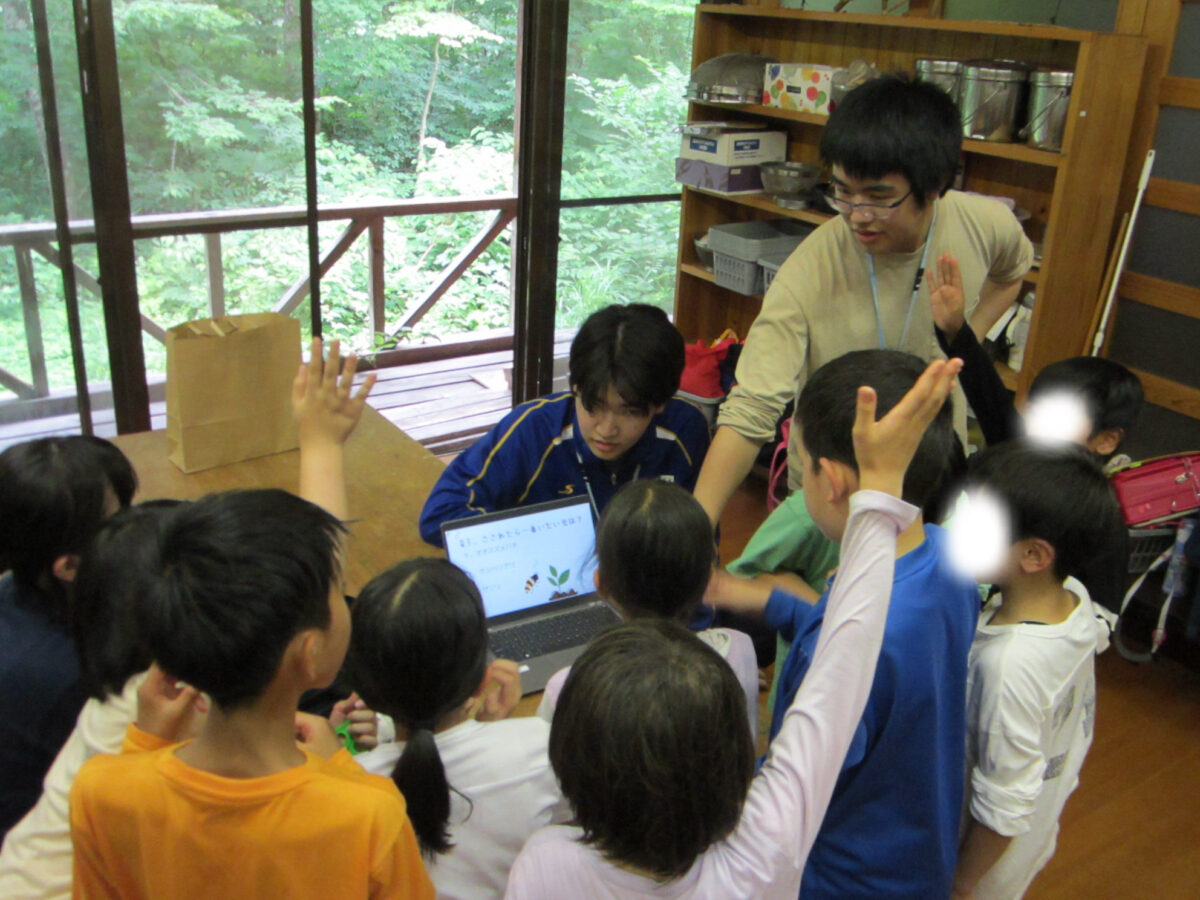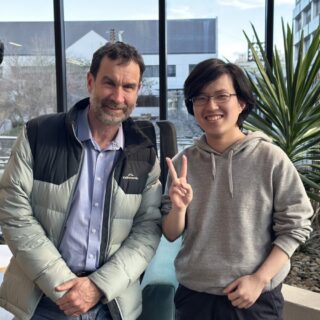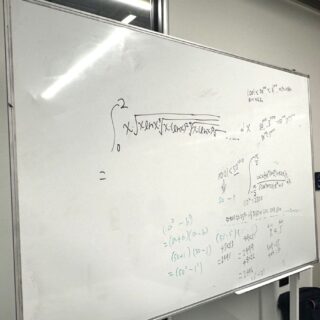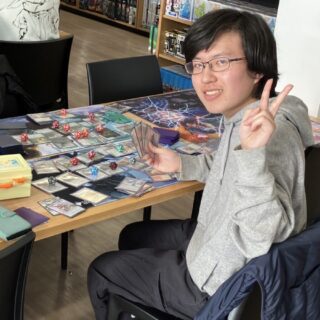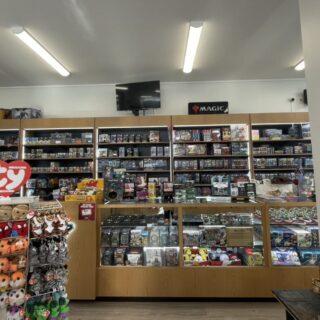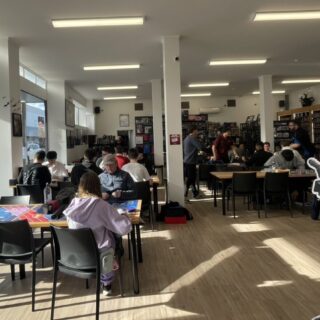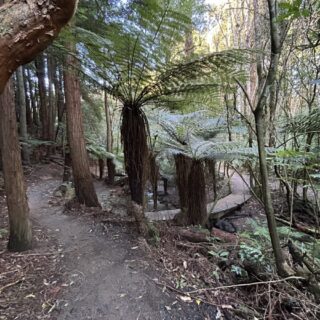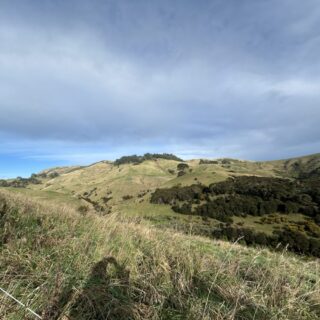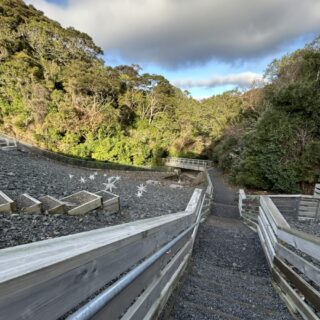FY 2025
2025年度の記事
こんにちは。エンジニアリングデザインⅡ(2年生)を担当している小髙 有普です。本校では、地域と連携した実践的な学びを重視しています。エンジニアリングデザインⅡでは、地域の農業課題に取り組みながら、技術とビジネスの両面から解決策を考える授業を行っています。テック班は芋を守るための獣害対策を技術的に支援し、ビジネス班は守られた芋を地域ブランド芋として販売することで地域活性化を目指します。
この授業で学生たちに求められることは、現状を正しく理解をしたうえで、地域活性の新たな方法を見出し、実現するための設計目的を持つことです。そのため、この地域で栽培する意味や効果、栽培に必要なものや労力などを多角的に理解する必要があります。そこでまずはクラス全員で、畝作り、植え付け、獣害対策用の電気柵設置を行いました。
2025年5月26日 鹿田校長先生のジャーナル「紅はるか苗植え」
-
Identifying current issues and brainstorming ideas by Business Teamビジネス班による現状の洗い出しとアイデア検討の様子
-
Installation of electric fences for wildlife protection電気柵取り付けの様子
今年は4月半ばにもかかわらず、畑には50センチ以上の雪が残っており、気温も上がらず、苗を植えることは難しい状況でしたが、奇跡の長雨により雪が解け、注文していた苗の納品時期に植え付けができました。しかし、今年の春の気温は10度前半で寒く、発根、成長には適温ではなく、苗は元気がない状況で心配しました。5月に入り、ようやく気温も上昇し始め苗の成長が見られるようになり、ほっとしました。
苗が活着した後も時々苗の様子を見に行っていたのですが、今年は苗が抜けているという事態が起こっていました。ネットで調べたところ、植え付け直後の苗は、カラスにとって格好の餌となるとのことが事例として挙げられており、本校の畑も同じことが起こっているのかもしれません。また、ワイヤーメッシュをポールに結束するための針金に電気柵が引っかかって弛んでいる状況もありました。来年は植え付け後に畑で何が起こっているのか、カメラを設置し注意深く観察する必要がありそうです。今年も芋販売をしますので、とびきり甘い高専紅はるかをご堪能ください。
小髙 有普
Hello, this is Arihiro Kodaka, and I am in charge of Engineering Design II for 2nd year students. At ICT, we place great importance on practical learning in collaboration with the local community. In Engineering Design II, students tackle agricultural challenges faced by the region and explore solutions from both technological and business perspectives. The Tech Team provides technical support for wildlife damage prevention to protect sweet potatoes, while the Business Team works to revitalize the community by marketing the protected sweet potatoes as a local brand product.
In this class, students are expected to accurately understand the current situation, identify new approaches to revitalizing the local community, and establish clear design objectives to realize those ideas. To achieve this, it is essential for them to gain a multifaceted understanding of the significance and impact of cultivating crops in this region, as well as the resources and effort required. As a first step, the entire class participated in creating ridges in the field, planting sweet potatoes, and installing electric fences to prevent wildlife damage.
Please also refer to the Hakusanroku Journal written by President Maasaki Shikada,
“2nd Year Engineering Design: Beniharuka Sweet Potato Planting (May 26th, 2025)"
-
Identifying current issues and brainstorming ideas by Business Teamビジネス班による現状の洗い出しとアイデア検討の様子
-
Installation of electric fences for wildlife protection電気柵取り付けの様子
Although it was already mid-April this year, more than 50cm of snow remained in the field, and the temperatures were still low, making it difficult to plant the seedlings. However, thanks to a miraculous period of continuous rain, the snow melted just in time for the scheduled delivery of the seedlings, allowing us to proceed with planting. However, the temperatures this spring were in the low 10℃, which was quite cold and not ideal for root development or growth. The seedlings didn’t look very healthy, and I was worried. Fortunately, in May, the temperatures finally started to rise, and I was relieved to see the seedlings beginning to grow.
Even after the seedlings had taken root, we continued to monitor their condition. This year, I noticed that some seedlings had been pulled out. Upon researching online, we found reports indicating that newly planted seedlings can be an easy target for crows, which may be what happened in our field as well. Additionally, we observed that the electric fence had become loose due to the wire mesh getting caught on the binding wire used to secure it to the poles. Next year, we plan to install a camera to closely monitor what happens in the field after planting. We will be selling sweet potatoes again this year, so please enjoy our exceptionally sweet Kosen Beniharuka!
Arihiro Kodaka
夏といえば虫の季節。冬でもカメムシに出会えるこの白山麓キャンパスですが、やはり夏の虫は別格です。よね?
こんにちは。つついです。6月末、地区のコミュニティセンターが主催する白嶺小学生の放課後活動に、本学の学生と一緒に参加してきました。
授業が3限で終わる水曜日の放課後、2年の中澤 円香さん、1年の大澤 凱さん、坂井 麗央さん、樋口 洸太朗さんの4名が、キャンパスから車で3分ほどの所にある小中学校裏の森で、地域の子どもたちと虫とり交流を楽しみました。大澤さんはMy網持参です。
私たちが到着したときには、低学年の子どもたちが元気いっぱいに虫とりの真っ最中で森はにぎやかな声に包まれていました。しばらくして高学年の子どもたちが合流し、全員で虫とりがはじまると、森はさらににぎやかになりました。
「虫とり」といえば、網を手にチョウやトンボを追いかけたり、木にとまったセミやクワガタ、跳ねるバッタやコオロギをつかまえたりする、そんなイメージがありませんか。ところが、低学年の子どもたちが見つけるのは、葉っぱや枝にひっそりと潜んでいる小さな虫たち。「ここにいるよ!」と虫の居場所を指さしてくれるのですが、あまりにも小さく、葉の色に同化しているうえに、最近は老眼もあってなかなか見つけられません。そんな私には見えない虫を、子どもたちは、はさみの先にカプセルのついた道具を使って確実につかまえていきます。
初夏という季節柄、虫たちもまだ成長途中なのかもしれません。でも、彼らにとってはどんなに小さな虫でも立派な「虫」。見つけた瞬間の歓声とキラキラした目がとても印象的でした。
この日、子どもたちがつかまえたのは、小さな虫たちのほか、バッタ、コオロギ、クワガタ、テントウムシ、ダンゴムシ、ナナフシ・・・そしてなんとカエルまで!
虫とりのあとは、学生たち手作りの虫クイズで盛り上がりました。虫とりに参加している子どもたちはさすがの知識量。難問にも次々と正解していました。
本校の学生たちは、それぞれの関わり方で子どもたちとの交流を楽しんでいました。普段キャンパスから眺めている空や森が、きっと、いつもとは違って見えたことでしょう。
白山麓キャンパスは自然に囲まれていますが、平日は校舎内での学びが中心で、自然や地域の人たちとふれあう時間はそれほどないのが現実です。加えて交通の便がよくないため、休日に気軽に白山麓を散策するということも難しい環境にあります。
今回、短い時間でしたが、学生たちは地域社会の一員であるという自覚が持て、「本当の自然」を肌で感じる体験ができたのではないかと感じています。
虫とりから3か月が過ぎ、あの小さな虫たちは大きくなったのでしょうか……。今なら、私の目でも見えるかもしれません。
つつい まさこ
Summer is here, and with it comes the season of insects. Even in winter, we encounter stink bugs on the Hakusanroku Campus, but summer insects are truly in a class of their own, aren’t they?
Hello, this is Tsutsui. At the end of June, I joined an after-school activity for Hakurei elementary school students organized by the local community center, together with students from ICT students.
On a Wednesday afternoon after third period classes ended, four students—Madoka Nakazawa (2nd year), Kai Osawa (1st year), Reo Sakai (1st year), and Kotaro Higuchi (1st year)—visited a forest behind a nearby elementary and junior high school, just a three-minute drive from Hakusanroku Campus to enjoy insect catching with local children. Kai even brought his own insect net!
When we arrived, the younger Hakurei students were already energetically catching insects, and the forest was filled with lively voices. Later, older grades hakurei students joined in, and the forest became even more vibrant as everyone began catching insects together.
When you think of “insect catching,” you might imagine chasing butterflies and dragonflies with a net, or catching cicadas, beetles, grasshoppers, and crickets. However, the younger hakurei students were finding tiny insects quietly hiding on leaves and branches. They would point and say, “Here it is!”—but the insects were so small and blended in with the leaves that I couldn’t see them, especially with my aging eyes. The Hakurei students skillfully used a tool, which has a capsule at the end of a pair of tweezers, to catch them quickly and easily.
Perhaps because it was early summer, the insects were still in the process of growing. But to the hakurei students, even the tiniest insect was a real “bug.” Their excited cheers and sparkling eyes when they found one were truly memorable.
That day, the hakurei students caught not only tiny insects, but also grasshoppers, crickets, beetles, ladybugs, pill bugs, stick insects—and even a frog!
After the insect catching, ICT students hosted a original insect quiz, which was a big hit. The hakurei students, already knowledgeable from their insect-catching experience, answered even the difficult questions with ease.
The ICT students enjoyed interacting with the hakurei students in their own unique ways. The sky and forest they usually see from campus must have looked quite different that day.
Although Hakusanroku Campus is surrounded by nature, students mostly study indoors during the week, and don’t often have opportunities to interact with the local community or nature. Moreover, due to limited transportation options, it’s not easy to explore the area on weekends.
This short experience gave the ICT students a chance to feel like part of the local community and to truly connect with nature.
I wonder if those tiny insects have grown bigger… Maybe now, even I could spot them.
Three months have passed since we went bug catching. I wonder if those tiny insects have grown... Maybe now, even I could see them with my own eyes.
Tsutsui Masako
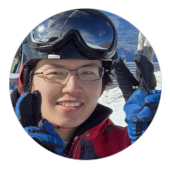 芭蕉は、350年ほど前の7月13日に『 閑さや 岩にしみ入る 蝉の声 』と詠んだそうですが、今年の夏は温暖化の影響で、7月に入っても蝉が鳴かないと各地でニュースになっていました。そこから一か月、日本はまだまだ厳しい暑さかと思います。みなさま、いかがお過ごしでしょうか。地球の反対側から、国際理工学科3年の鴨下 麟太郎です。ニュージーランドに住む我々の生活は、そんな日本とは非常に対照的で、暖炉にて薪を燃やし、寒さをしのぐ毎日です。今回は、そんなニュージーランドの日常の中でも、国際高専サブカルチャー担当の僕の、非日常な日常を紹介していこうと思います。
芭蕉は、350年ほど前の7月13日に『 閑さや 岩にしみ入る 蝉の声 』と詠んだそうですが、今年の夏は温暖化の影響で、7月に入っても蝉が鳴かないと各地でニュースになっていました。そこから一か月、日本はまだまだ厳しい暑さかと思います。みなさま、いかがお過ごしでしょうか。地球の反対側から、国際理工学科3年の鴨下 麟太郎です。ニュージーランドに住む我々の生活は、そんな日本とは非常に対照的で、暖炉にて薪を燃やし、寒さをしのぐ毎日です。今回は、そんなニュージーランドの日常の中でも、国際高専サブカルチャー担当の僕の、非日常な日常を紹介していこうと思います。
みなさんがそうでないことは重々承知ですが、基本的に、僕の一日は数学の問題を解くことに始まり、数学の問題を解くことで終わります。国際高専にいるうちは、ロボコン(それが理由の大半ですが)や課題に追われ、祝日にしか解く時間はありませんでした。しかし、ニュージーランドに来ると、生活は一変しました。端的に言えば、一日に24時間を超える自由時間を手に入れることができたのです。これにより、夜、大体2~3時間ほど数学の勉強をして、それ関連の問題を1問選び、その問題を次の日の朝に解くという、どこかにありそうな勉強法のような生活を送れるようになったのです。ニュージーランドに着いてから、生活の中で数学のことを考えられる時間というのはすごく増えました。休日によくオタゴポリテクニクに行き、ホワイトボードに問題と解答プロセスを記載し、残したまま帰るという、さながらホームズの『踊る人形』のような形で、数学好きにのみ伝わる暗号を作っていたのですが、つい先日、数学の先生がその問題を見たようで、その話で盛り上がることができました。数学は言語だという人もいますが、まさに数学という言語で、コミュニケーションの漸近線を越えた瞬間でした。
-
Sharing a great moment with Mark Harmer, the inspiring math lecturer at Otago Polytechnic — we really hit it off!意気投合した、オタゴポリテクニクの数学担当教員、Mark Harmer先生と共に
-
A holiday spent with classmates, playing with an unsolvable expression — all that remains is a trace of our battle, like a dream. とある休日にて、クラスメイトと、解けない数式で遊んだ、”兵どもが、夢の跡”
サブカル担当と言っておきながら、ここまで数学の話しかしていないので、ここからは僕のダニーデンでのカードゲームライフについてご紹介していきます。
まず初めに、ニュージーランドにはカードをバラ売りしているお店がありません。「知らねぇよ」と思うかもしれませんが、これはカードゲーマーにとっては、死刑宣告に限りなく近い事実なのです。そのうえ、ダニーデンにはカードショップが1つしかありません。そのため、僕は5歳の頃から数えて、おそらく初めて、「カードゲームをしない月」を3か月過ごすことになります。
しかし、7月中旬、転機は訪れます。ある土曜日のことでした。その日はスケートをしに、友人と南部のスケートリンクに遊びに行っていました。その帰り道、たまたま見かけたそのカードショップの看板が、日本の有名なキャラクターだったのです。思わず目に留め、中に入ってそのカードゲームの商品を物色していると、店主さんが僕に話しかけてきてくれました。店主さんと話していると、毎週日曜日に大会が行われていることを教えてくれました。翌日、友人と共にその大会に参加し、人生初のカードゲーム国際交流ができました。
そこで、一つ驚きの事実が発覚しました。ニュージーランド人は、基本的に自由で、日本人とはベクトルの違う、言うなれば、「海外の人」の雰囲気がありますが、カードゲームコミュニティは、日本と全く変わりませんでした。周りと比べ強すぎるデッキを使えば嫌がられ、事故(運が悪く、目に見えて負けていること)った人には攻撃しないでおこうというような配慮などが見られ、インターネットでしばしば見かける、日本人と発言一致な「海外ニキ」は、日本人の仕込みではないことが分かりました。
-
A refreshing smile after a joyful day with friends and new local faces.友人と共に、初対面の現地人と遊びまくった日の清々しい笑顔
-
At the counter of a card shop. カードショップのカウンター
-
A packed play area full of energy.活気づく店内
ここまで、僕のニュージーランド生活についてお話してきましたが、最後に、このジャーナルを読んでいる白山麓キャンパスの学生や、入学を考えている中学生に向けて、メッセージを伝えて終わりにしたいと思います。このジャーナルを通して、僕が伝えたいのは、「英語能力は問われない」ということです。…盛りました。「コミュニケーション能力の方が重要だ」ということです。
僕は、電子ゲームやスポーツなど、人とつながれる定番の趣味を持っていません。しかも、若者と喋るのが好きではないという最悪のハンデを抱えています。それでも、日本で培った、先生と喋る技術とカードゲームで喋る技術で戦うことができています。この二つは、僕の言葉に耳を傾けてくれる瞬間が、自動的に訪れるという、すごくありがたい性質を持っています。みなさんもニュージーランドに来る前に、ニュージーランドでどうやって英語のコミュニケーションを取るかの戦略は立てた方がいいと思います。僕は日本人の家にホームステイしていて、英語を日常的には用いらないのですが、他の学生と比べても、英語に触れる頻度は変わりません。これは戦略勝ちとしか言いようがないです。ダニーデンは間違いなく、素晴らしい環境です。だからこそ、日本に帰りたいという欲望と見知らぬ天井との苦闘ではなく、「自分の成長の場」として捉えてほしいと思っています。
P.S. 信州人なので、本当は小林一茶にしたかったです。
鴨下 麟太郎
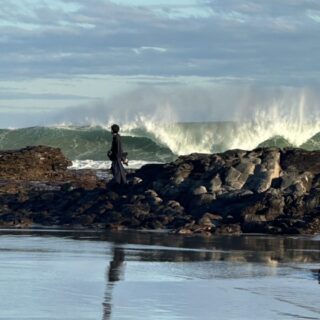
 About 350 years ago, on July 13th, the famous poet Matsuo Basho wrote the haiku:
About 350 years ago, on July 13th, the famous poet Matsuo Basho wrote the haiku:
“How still it is here—
Stinging into the stones,
The locusts' trill.”
But according to the news this year, because of global warming, people in many places said that cicadas did not sing even after July began. Now, one month later, Japan is still in the grip of a very hot summer, I believe. How are you all doing? From the other side of the Earth, I am Rintaro Kamoshita, a 3rd year student at International College of Technology, Kanazawa.
Our life in New Zealand is very different—almost the exact opposite—from the summer in Japan. Every day we burn firewood in the fireplace to fight the cold. Today, I would like to tell you about my “unusual daily life” here in New Zealand, especially as the person who is sometimes called the “subculture manager” of our school.
First, I know you may not be the same, but for me, a day usually begins with solving a math problem, and ends with solving another math problem. When I was in Japan, at ICT, I did not have much time for such study, because I was busy with Robot Contest preparation and with many assignments. Only on holidays could I do math freely. However, after coming to New Zealand, my life changed a lot. Simply put, I gained “more than 24 hours of free time in one day.” Because of this, I could make a new style: at night, I study math for two or three hours and choose one problem, and then I try solving that problem the next morning. Thanks to this, I now have a lot more time to think about math in my daily life here.
On holidays, I often go to Otago Polytechnic. There, I write a math problem and its process of solution on a whiteboard, and leave it there before going home. It was like creating a secret code that only those who love math could understand—much like the one in Sir Arthur Conan Doyle’s The Dancing Men. Recently, one math teacher saw my problem and we were able to talk about it. Some people say that “math is a language.” I felt that it was really true, because at that moment, we crossed the boundary of ordinary communication by using the language of math.
-
Sharing a great moment with Mark Harmer, the inspiring math lecturer at Otago Polytechnic — we really hit it off!意気投合した、オタゴポリテクニクの数学担当教員、Mark Harmer先生と共に
-
A holiday spent with classmates, playing with an unsolvable expression — all that remains is a trace of our battle, like a dream. とある休日にて、クラスメイトと、解けない数式で遊んだ、”兵どもが、夢の跡”
But since I am supposed to talk about subculture, I should now speak about my “card game life” in Dunedin. First, let me tell you something surprising: in New Zealand, there are no shops that sell single cards. You may think “so what?” but for card gamers, this is almost like a death sentence. What is worse, in Dunedin, there is only one card shop in the whole city. Because of this, I had to spend three months without playing card games. This was maybe the first time since I was five years old.
However, in mid-July, something changed. One Saturday, I went skating with my friends at the southern ice rink. On the way back, I found a card shop, because I saw a sign with a very famous Japanese character. I went inside and looked at the card products. Then the shop owner talked to me, and told me that every Sunday they have a tournament. The next day, I joined the tournament with my friend, and I had my first international card game exchange.
There, I found something surprising. In general, New Zealand people are very free, and their way of thinking is different from Japanese people. But in the card game community, everything was almost exactly the same as in Japan. For example, if someone used a very strong deck, other players did not like it. And if someone was very unlucky and already almost losing, other players tried not to attack too hard. On the internet, I often saw people saying “foreign players act just like Japanese ones.” I found out that this was true.
-
A refreshing smile after a joyful day with friends and new local faces.友人と共に、初対面の現地人と遊びまくった日の清々しい笑顔
-
At the counter of a card shop. カードショップのカウンター
-
A packed play area full of energy.活気づく店内
Now, I want to finish my journal with a message to the students in the Hakusanroku Campus, and also to junior high school students who are thinking of entering our school. What I want to say is this: English ability is not the most important thing. …Okay, maybe I exaggerated. What I really mean is: communication ability matters much more.
I don’t play popular games, or popular sports. Also, I do not enjoy speaking with young people very much. In other words, I have some serious handicaps. But even so, I can still “fight,” thanks to two things I learned in Japan: the skill of talking with teachers, and the skill of talking through card games. These two skills have a special power: they automatically create a moment when the other person listens to me. So I recommend that you also make a strategy about how to communicate in English before you come to New Zealand.
For example, I live in a homestay with a Japanese family, so in daily life I do not use much English. But still, compared with other students, the amount of English I touch is not any less. That is, I can say I won by strategy. Dunedin is truly a wonderful place. So I hope you can make it not a place of suffering and homesickness, but a place of your own growth.
P.S. Actually, I am from Shinshu, so I wanted to start with Kobayashi Issa, not with Matsuo Basho.
Rintaro Kamoshita

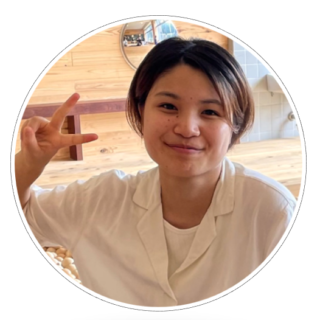 こんにちは。3年の中澤 琉月です。現在、ニュージーランドは真冬で、日本の1月ごろと同じような寒さを感じます。そのため、外ではダウンなどの上着が欠かせません。今回は、そんなニュージーランドでの私の日常を少しご紹介します。
こんにちは。3年の中澤 琉月です。現在、ニュージーランドは真冬で、日本の1月ごろと同じような寒さを感じます。そのため、外ではダウンなどの上着が欠かせません。今回は、そんなニュージーランドでの私の日常を少しご紹介します。
私が滞在しているホームステイ先には、ホストマザー、ホストファザー、同年代のホストシスター2人がいます。滞在当初はハウスメイトが2人いましたが、そのうちの1人は最近帰国しました。そのハウスメイトとは共通点が多く、短い間でもとても仲良くなることができました。ホストファミリーとは毎日たくさん話すわけではありませんが、みんなユーモアがあって、リビングで一緒に過ごしているだけで思わず笑ってしまうようなことがよく起こります。また、家には大型犬が1匹いて、よく一緒に遊んでいます。
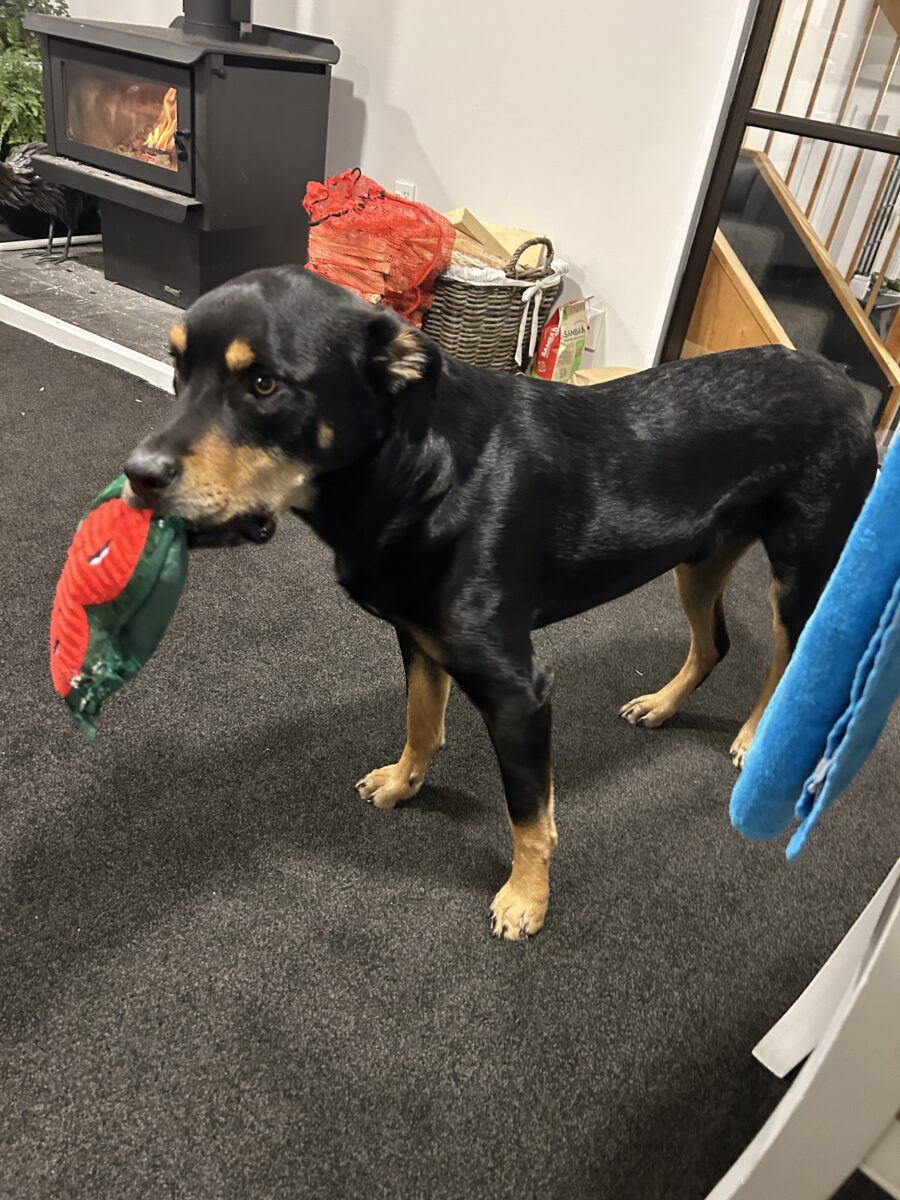
My host family‘s dogホストファミリーが飼っている犬
家は少し高台にあり、リビングからは海まで見渡せる広大な景色を楽しめます。オーロラが出た夜にはベランダからその幻想的な光景を一望することもできました。さらに、ダンスフロアが敷かれたガレージや電子ピアノもあり、自分の趣味であるダンスやピアノを存分に楽しめる、まさに私にぴったりな環境です。
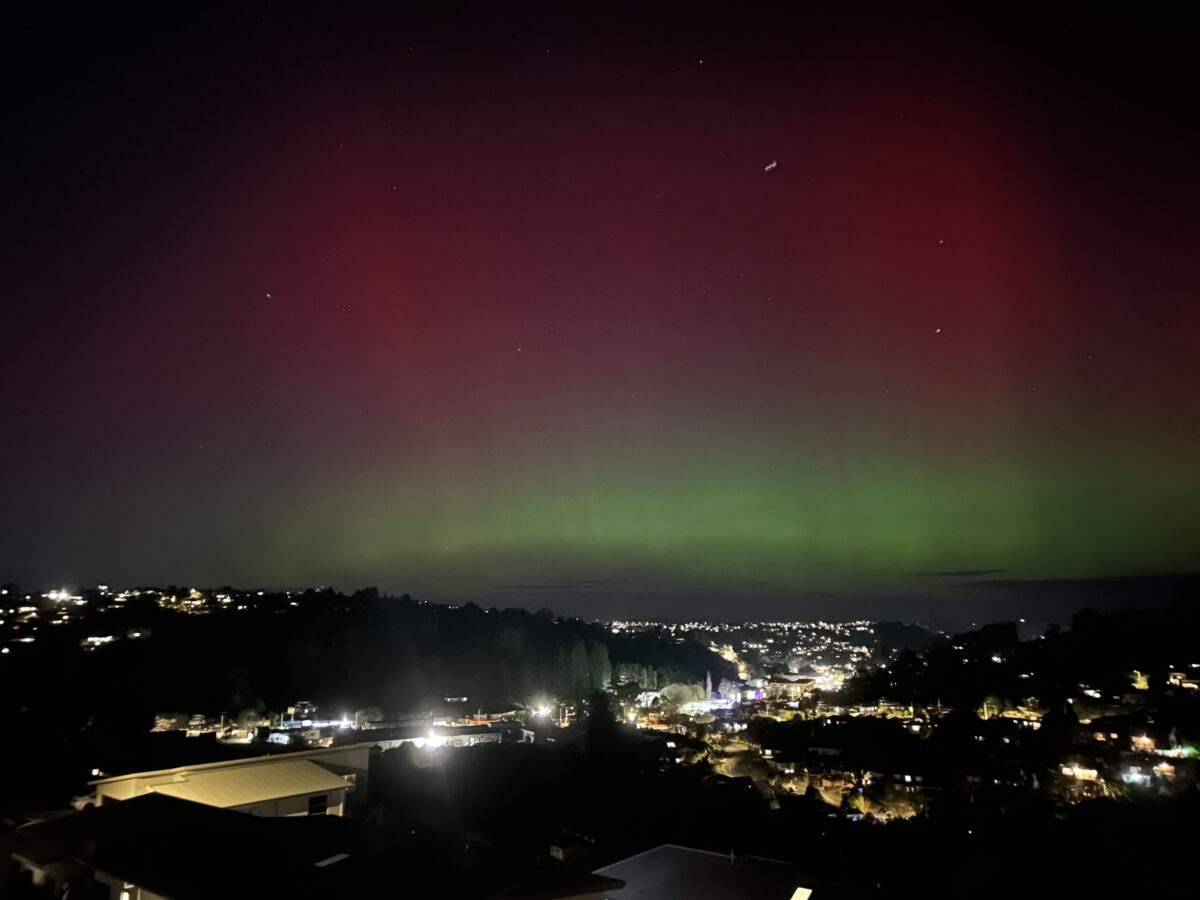
The aurora seen from the balconyベランダから見えたオーロラ
こちらでの授業数は1・2年のときよりも少なく休日も多いため、より自由な時間が増えました。そのおかげで、ピアノやダンス、絵などの趣味にたっぷりと取り組めています。ダンスについては、オタゴポリテクニク内のクラブにも入り、毎週のレッスンでスキルを磨いています。ほかにもAIについてのオンラインコースを受講するなど、自分の興味を深めることにも時間を使うようにしています。
また、自然豊かなニュージーランドならではの楽しみとして、トレッキングにもよく出かけています。ダニーデンには行政が整備したコースが多く、市のサイトを見て場所を選んでいます。場所によって異なる景色や日本では見かけない植物に出会え、とても面白いです。犬好きの私にとって、道で出会う散歩中の犬たちも癒しの存在です。
穏やかで充実した日々を送る一方で、悩みもあります。それは英語力、特にスピーキングについてです。英語に囲まれた環境には慣れてきたものの、自信のなさから自分から話すことにまだ苦手意識があります。
留学生活も3分の1が過ぎました。ホストファミリーに囲まれた温かい環境と、自由に使える時間を活かして、これからも少しずつ挑戦を重ね、自分の成長につなげていきたいと思います。
中澤 琉月
 Hello, I’m Ruuna Nakazawa, a 3rd year student at ICT. Right now, it's the middle of winter in New Zealand, and it’s as cold as in January in Japan. Because of that, warm outerwear like a down jacket is essential when going outside. Today, I’d like to share a bit about my daily life here in New Zealand.
Hello, I’m Ruuna Nakazawa, a 3rd year student at ICT. Right now, it's the middle of winter in New Zealand, and it’s as cold as in January in Japan. Because of that, warm outerwear like a down jacket is essential when going outside. Today, I’d like to share a bit about my daily life here in New Zealand.
I’m staying with a host family that includes a host mother, a host father, and two host sisters who are around my age. When I first arrived, there were also two other housemates, but one of them recently returned to her home country. I had a lot in common with her, and even though we only spent a short time together, we became very close. I don’t talk with my host family extensively every day, but they all have a great sense of humor, and simply spending time together in the living room often brings lots of laughter. There's also a large dog at home, and I often play with it.

My host family‘s dogMy host family‘s dog
The house is located on a hill, and from the living room I can enjoy a wide view that includes the sea. One night, when the aurora appeared, I was able to watch the beautiful display right from the balcony. The house also has an electric piano and a garage with a dance floor, creating the perfect environment for me to fully enjoy my hobbies—playing the piano and dancing.

The aurora seen from the balconyThe aurora seen from the balcony
I have fewer classes here than I did during my 1st and 2nd years, and there are more holidays as well, so I now have more free time. Thanks to that, I’ve been able to spend plenty of time on my hobbies like piano, dance, and drawing. Speaking of dance, I’ve joined a dance club at Otago Polytechnic and take weekly lessons to improve my skills. I’m also taking an online course about AI, using my free time to deepen my interests.
One unique feature of New Zealand is its rich natural environment, and I’ve been going on hikes regularly to experience it. Dunedin has many well-maintained walking tracks managed by the local government, and I choose where to go by checking the city’s website. Each location offers different scenery and plants that I wouldn’t find in Japan, which makes each hike fascinating. As a dog lover, I also enjoy encountering dogs out on their walks.
While I’ve been enjoying these peaceful and fulfilling days, I also face some challenges. One of them is my English ability, especially speaking. Although I’ve gotten used to being surrounded by English, I still lack the confidence to actively start conversations on my own.
Now that a third of my study abroad experience has passed, I want to continue making the most of this warm host family environment and the free time I have, taking on new challenges little by little, and continuing to grow as a person.
Ruuna Nakazawa

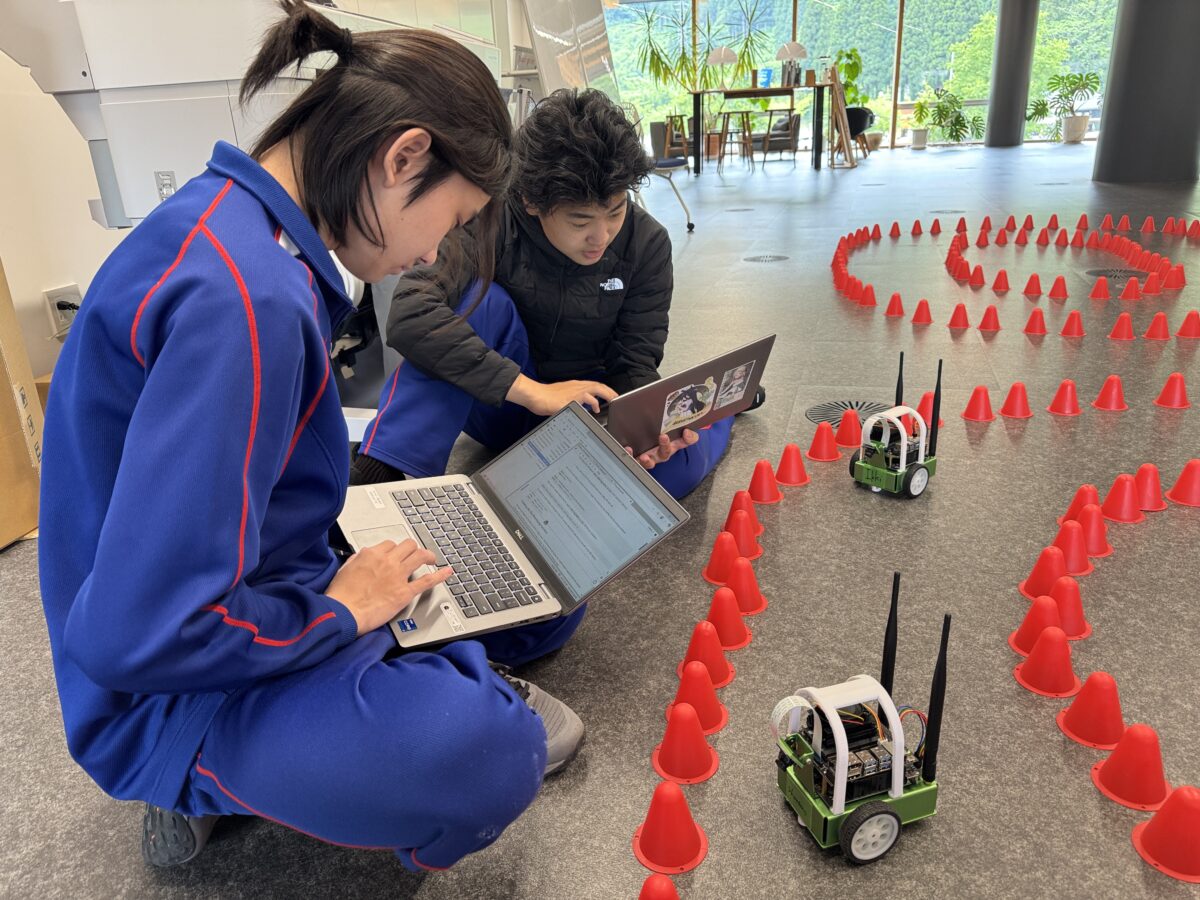 こんにちは。ハヤト・オガワです。白山麓キャンパスで、エンジニアリングデザインⅡA(2年生)とコンピュータスキルズⅡA(2年生)の授業を教えています。AIや未来をテーマにした映画が好きな私にとって、1968年公開の映画「2001年宇宙の旅」(原題:2001: A Space Odyssey)のような作品では、テクノロジーがどのように想像され、そして時に脅威として描かれている様子を見ることはとても興味深いです。AIをただ恐れるのではなく、その仕組みを理解し、責任を持って制御する方法を一緒に学んでみませんか。
こんにちは。ハヤト・オガワです。白山麓キャンパスで、エンジニアリングデザインⅡA(2年生)とコンピュータスキルズⅡA(2年生)の授業を教えています。AIや未来をテーマにした映画が好きな私にとって、1968年公開の映画「2001年宇宙の旅」(原題:2001: A Space Odyssey)のような作品では、テクノロジーがどのように想像され、そして時に脅威として描かれている様子を見ることはとても興味深いです。AIをただ恐れるのではなく、その仕組みを理解し、責任を持って制御する方法を一緒に学んでみませんか。
JetBotプロジェクトが2年生のコンピュータースキルズの授業に導入されてから数年が経ちましたが、この実践的な活動はICTのカリキュラムの重要な一部となっています。時間が経つ中で、ハードウェアの故障や操作中の落下事故により、いくつかのJetBot が使えなくなることもありましたが、このプロジェクトは今でもロボティクスと人工知能の学びとして貴重な体験となっています。
実践を通じて学ぶ:Pythonから衝突回避まで
NVIDIA Jetson Nanoマイクロコンピューターを基盤とするJetBotプラットフォームは、学生がAIを活用したロボティクスの実践的な学びの入門に適しています。学生はまず、ロボットを制御するための基本的なPythonプログラミングを学び、次に画像収集を通じてデータセットを作成し、最終的に衝突回避モデルの開発に取り組みます。搭載されたカメラを活用しながら、各学生は自分のJetBotを障害物コースで安全に走行させるための訓練を行い、理論的な知識と実践的なスキルの両方を応用して、データセットやモデルの品質が動作にどのような影響を与えるかを理解していきます。
この活動は、長年にわたり学生たちのAIやロボティクスに対する理解を深めるだけでなく、高品質なデータの重要性、慎重に問題を解決する力、そしてシステムの信頼性の大切さについても学ぶきっかけになっています。こうしたスキルは、将来エンジニアリングやテクノロジーの分野で活躍するうえで不可欠なものです。AI技術が主流になりつつある今、将来的に、自動運転車などの分野で働く学生も出てくるかもしれません。そうした分野では、精度やデータの完全性が実際の社会に直接影響を与えるのです。
挑戦を乗り越え、成長へとつなげる
JetBotの公式ドキュメントやプログラミング教材は大学レベルの英語で書かれているため、それを理解するために英語力が必要なことが課題となっています。しかし、教員とラーニングメンターによる継続的なサポートと指導により、学生たちは言語の壁を乗り越えながら、技術・学術的なスキルの両方を身につけています。
一部のJetBotsは修理が必要とある場面もありましたが、どの出来事も貴重な学びの機会となり、実際のハードウェアを扱うことの現場を体験することにつながりました。このJetBotプロジェクトは、プログラミング、人工知能、そして実践的なトラブル対応力を融合させた、実践的かつ学際的な教育プログラムとして、進化を続けています。ICTは、学生たちが現代の技術社会で活躍できるよう、確かな力を育む取り組みをこれからも続けていきます。
ハヤト・オガワ


Hello, this is Hayato Ogawa (Associate Professor) at International College of Technology. I teach Engineering Design 2 and Computer Skills 2 classes at Hakusanroku campus. As someone who enjoys watching science fiction movies about AI and the future—like 2001: A Space Odyssey—I’m always fascinated by how technology is imagined and sometimes feared. Instead of fearing AI, I believe it's important to understand how it works and how we can control it responsibly.
Several years have passed since the introduction of the JetBot project in the Computer Skills 2 class, and this hands-on activity remains an integral part of the curriculum at ICT. Despite the passage of time and the occasional loss of a few JetBots due to hardware failures or accidental falls during operation, the project continues to provide students with a valuable introduction and experience in both robotics and artificial intelligence.
Learning Through Doing: From Python to Collision Avoidance
The JetBot platform, built on the NVIDIA Jetson Nano microcomputer, offers students a practical introduction to AI-based robotics. Students begin by learning basic Python programming to control their robots, followed by creating datasets through image collection, and ultimately developing collision avoidance models. By using the onboard camera, each student trains their JetBot to navigate safely through obstacle courses, applying both theoretical knowledge and practical skills to understand how the quality of their dataset and models affects operation.
Over the years, this activity has not only strengthened students’ understanding of AI and robotics. It has also emphasized the importance of high-quality data, careful problem-solving, and system reliability, cultivating essential skills for future careers in engineering and technology. As I noted when the program was first introduced, AI technology is becoming mainstream; some students may eventually work in fields such as autonomous vehicles, where accuracy and data integrity have direct real-world implications.
Overcoming Challenges and Fostering Growth
One ongoing challenge remains the English proficiency required to navigate the official JetBot documentation and programming materials, which are written at a university level. However, with the consistent support and guidance of faculty members and learning mentors, students can overcome these language barriers while developing both technical and academic skills in the process.
While a few JetBots have been repaired along the way, each incident has provided additional learning opportunities, reinforcing the realities of working with physical hardware. The JetBot project continues to serve as a meaningful, multidisciplinary learning experience that combines programming, artificial intelligence, and practical troubleshooting. It remains a strong example of ICT’s commitment to preparing students for the demands of the modern technological landscape.
Hayato Ogawa









